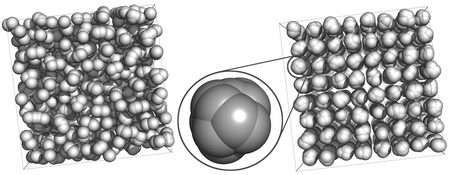When Repulsive Particles Stick Together - A New Angle On Clustering

Even when they mutually repel each other, material particles in a solution can still form clusters. Details on the conditions necessary for this seemingly contradictory phenomenon have now been published. Though they come from the realm of theoretical physics these findings may be very important for understanding of the ordering of polymer-like entities.
Milk and mayonnaise, paints and inks, proteins and DNA are all examples of what is known as "soft matter". It is only recently that their physical characteristics have been systematically investigated, often with surprising outcomes. One such result has now been published by a group led by Prof. Gerhard Kahl of the Institute of Theoretical Physics at the Vienna University of Technology.
Hard Facts on Soft Matter
"Intuitively, you would only expect particles in a fluid to aggregate when they attract each other," explained Prof. Kahl, "but we have been able to show that this needn't always be the case. Even particles that completely repel each other can form clusters." The conditions necessary for this can be created by a particular type of soft matter, known as colloidal dispersions. In such systems, relatively large particles (e.g. polymers) are dissolved in a solvent made up of far smaller particles.
Together with colleagues at the Universities of Vienna and Düsseldorf, the team has now carried out computations on these types of solutions and has clearly shown that particles which repel each other can still aggregate, provided that two conditions are met. Firstly, the particles must be able to overlap each other and, secondly, increasing the distance between them must lead to a rapid reduction in the strength of the repulsion.
If these conditions are fulfilled, then the seemingly contradictory behaviour of the particles can be observed. Mag. Bianca Mladek and Dr. Dieter Gottwald, both members of Prof. Kahl's team, have used complex computer simulations to confirm their surprising predictions. The strong agreement between the theoretical results and computer simulations convinced the referees, leading to publication in the prestigious Physical Review Letters journal.
Crystals under Pressure
The behaviour of particles when subjected to pressure yielded further unexpected results. Prof. Kahl commented: "Under high pressure, the clusters arrange themselves into crystals. We were even more surprised with the findings of further investigations which showed that the spacing between the ordered crystalline clusters remains constant when compressed further - a characteristic which is made possible by the aggregation of more and more particles in the clusters." These findings contrast with the behaviour of other ordered systems, such as ordinary crystalline metals, where the lattice spacings decrease under pressure.
Due to the high complexity of colloidal dispersions, such computations require certain mathematical tricks. Outlining the methodology, Prof. Kahl explained: "Statistical mechanics is the fundamental theory to describe soft matter behaviour. However, the large number of degrees of freedom of the larger particles in the dispersions posed a formidable computational problem. Through appropriate averaging we were able to dramatically reduce the number of degrees of freedom, so that the behaviour of the particles would only depend on a small number of coordinates."
Prof. Kahl believes that the findings, some of which are highly unexpected, show that nature offers a wide variety of solutions for the optimal energetic ordering of particles, many of which are still unknown. The FWF project will not only contribute towards unlocking some of these secrets, but will also help put the new field of soft matter research on a firm footing in Austria.
Original publication: Formation of Polymorphic Cluster Phases for a Class of Models of Purely Repulsive Soft Spheres. B. M. Mladek, D. Gottwald, G. Kahl, M. Neumann und C. N. Likos. Physical Review Letters 96, 045701 (2006). DOI: 10.1103/PhysRevLett.96.045701
Source: Austrian Science Fund FWF















